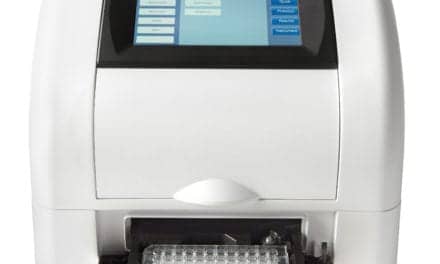This is a companion article to the feature, “Delivering on the Promise of NGS for Clinical Diagnostics.”
Processing a biological specimen from nucleic acid extraction through library preparation and sequencing to final report generation is a multistep, multiday process. Promoted as a complete sample-to-insight solution, the Qiagen GeneReader NGS system comprises all elements of an NGS workflow, and provides a presynchronized, single-vendor response to the challenges of performing NGS smoothly and efficiently. Key elements of the NGS workflow performed by the GeneReader NGS system include the following.

The GeneReader NGS system, comprising (from left) the QIAcube for nucleic acid extraction and library preparation, the GeneRead QIAcube for clonal amplification, the GeneReader platform for sequencing, and QCI Analyze and QCI Interpret software for automated bioinformatics analysis.
Nucleic Acid Extraction. The success of the sequencing process is highly dependent on the quality of the nucleic acid template. The most commonly available form of tumor sample is formalin-fixed paraffin-embedded (FFPE) biopsy tissue. While this format provides excellent preservation of tissue morphology for histological analysis, it also leads to artifacts at the DNA level caused by the deamination of cytosines, and resulting in cytosine to thymine transition. The GeneReader NGS system workflow starts with the nucleic acid extraction step and uses the GeneRead DNA FFPE kit with uracil-N-glycosylation to reverse such formalin artifacts. The extraction process is fully automatable on the QIAcube instrument to provide standardization during sample preparation.
Target Enrichment. A well thought out assay targeting genomic or transcriptomic regions relevant to a specific disease reduces workflow turnaround time, minimizes data output to just that required, and streamlines downstream analysis. However, it can be challenging to find an existing assay that covers the most actionable variants while at the same time being compatible with a lab’s sequencing platform and workflow. The GeneReader NGS system offers a menu of such assays targeting variants from different cancers. The assays are integrated as part of the complete workflow and coupled with an analytics pipeline tailored to each targeted assay. The assay panels are marketed as being of unparalleled relevance due to their inclusion of variants found to be implicated in disease.
Library/Template Preparation. Library preparation is a critical step in achieving successful sequencing; a low-quality library often results in very poor data. The library preparation process involves multiple hands-on pipetting steps, including template fragmentation, end-repair, and amplification. The GeneReader template preparation protocol is fully automatable first on the QIAcube and GeneRead QIAcube, minimizing sample handling time and amplification bias. Quality control steps are integrated as part of the protocol to ensure template integrity at each stage of the process.
Sequencing. There are several different NGS technologies on the market, each with different merits. The GeneReader platform uses the well-known sequencing-by-synthesis method. It offers staggered and parallel loading of flow cells, making sequencing runs scalable to a laboratory’s individual schedule and sample-batching requirements. The sequencing chemistry is optimized for compatibility with the rest of the workflow.
Data Analysis and Interpretation. NGS data is typically output as a raw FastQ sequence file. To go from this raw data to a meaningful result requires analysis via a bioinformatics pipeline to first identify variants, followed by a thorough literature search to establish the significance of those variants. In the GeneReader NGS system, variant discovery bioinformatics analysis is automated by QCI Analyze software. QCI Interpret then interrogates the Qiagen Knowledge Base, which contains curated journal articles, active clinical trials, and drug labels, to provide a report indicating the likely impact of each mutation identified by the assay.
Turnaround time is advertised as 5 days from sample prep to delivery of a report, with as little as 8 hours of hands-on time.
Add-on tools, including the GeneRead Link software for chain of custody of samples through the workflow (offering full connectivity with a laboratory information management system) and an iPad with virtual handbook app, complete the offering.
Currently designated for research use only, the GeneReader NGS system is a transitional solution aimed at smoothing the passage of NGS from a basic research tool to a future clinical diagnostic device. With this in mind, it claims to address many of the bottlenecks faced by clinical labs interested in capitalizing on NGS technology.




